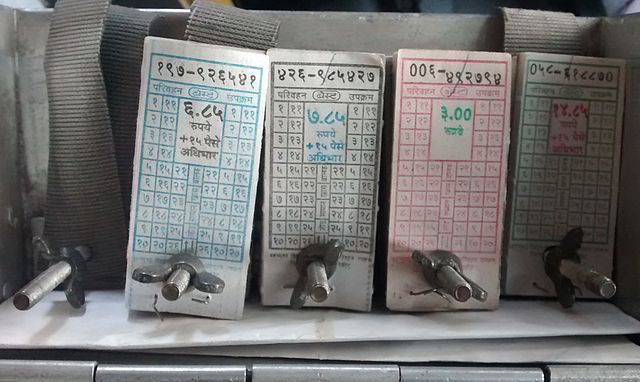NMMT Limited; after my previous post on BEST, seems to be an interesting development. Note I am only calling it NMMT Limited; the word Limited is just a figment of my imagination.
Back in 2014, NMMT had a meeting with several IT service providers, including Trimax, ARS, and Atos to set up an Intelligent Transport System [ITS], which would have brought NMMT more or less along the lines of BEST. However, nothing of the sort has taken place so far. I still see NMMT issuing punched tickets, they have no Bus tracking mechanisms like BEST, and their buses are mostly rickety. However, a recent article in ToI stated that NMMT was in talks with App Developers to create an app to book an AC Bus ticket. A rather interesting development indeed.
In November 2014, ten months ago, NMMT was issuing punched tickets on its Volvo bus on Route AC-105. I was given 3 tickets of ₹20, one of ₹10 and one of ₹5 for a ticket worth ₹75. This was two months after I had got my BEST smart card. The situation was the same in April 2015.

Now, with punched tickets, and no Electronic Ticket Machines in sight, this could only mean that NMMT is manually handling accounts as well. With such a system in place, how do they expect to go straight to App based bookings? How will the conductor add it to his or her tally? Or will they treat the passengers similar to the way they treat a passholder for a limited route or distance? There are a lot of questions involved in this, so let us have a look at the possible problems that might occur.
Let us take an NMMT route with significant competition along it and examine what might happen:
Route: Borivili Station [East] – Thane Station [East] via Ghodbunder
There are four buses that run primarily on this route:
- BEST 700Ltd: This is a non-AC service, with limited stops. [50 stops]
- BEST AS700: This is an Air-Conditioned service with fewer services than 700Ltd. [44 stops]
- TMT AC65: This an AC service with fewer stops than AS700. [18 stops]
- NMMT AC121: This is an AC service with the same number of stops as AS700. [44 stops]
Now, given the competition along this corridor, we can say that just like the Bangalore-Chennai or Mumbai-Pune corridor, if one misses one bus, rest assured they will have another one, assuming they are not a Pass holder or a BEST prepaid card holder. For most people living in Borivili, being passholders, AS700 would be the ideal choice. For those living in Thane, AC65 would be the ideal choice. NMMT ideally would be catering to commuters between Borivili and Airoli, or Thane and Airoli.
Now, NMMT is planning an app for its commuters to buy tickets. The purpose of the app can vary. It may be to allow cashless travel, or paperless travel like the Indian Railways UTS app for the Suburban Railway lines across Mumbai and Chennai. However, if this was the case, then why is NMMT still issuing punched tickets? Another purpose of the App can be to reserve a seat, similar to CityFlo or rBus. However, my question is, if NMMT is still on punched tickets, this will lead to a big mess. For example: What if all the seats in the bus are full, and a commuter waiting for the bus has reserved a seat using the app, and walks into the bus to see there are no seats free? The app-user cannot be denied a seat since they paid for it, and the conductor cannot ask a seated passenger to get up. Similarly, if the app is indeed for paperless ticketing like the Railway app, how does it help in curbing frauds? The UTS app currently works in two ways:
- One is the GPS method, which works on select routes, mostly the Western and Central lines wherein you have to be either inside the station premises or within a certain radius of the station in order for the app to work. The ticket doesn’t need to be printed and showing the app screen is enough if a TTE comes along.
- The second method is the Printed Ticket method. This works on non GPS enabled routes, where after a ticket is bought, it needs to be printed. A reference number is given, which can then be entered into an Automatic Ticket Vending Machine [ATVM] at the Origin Station. The ticket cannot be printed anywhere else to prevent frauds.
How does NMMT plan to do this? The first method would be problematic since not all buses are equipped with GPS, unlike their purple counterparts with the BEST. The second method would be cumbersome for the conductor to punch in a number into their machine, if they have one, to log it. Since, they use punched tickets, the conductor would have to note down the number on a sheet to submit to the depot manager.
All this leaves a lot to wonder. Is NMMT equipped to handle all this? Can they outdo BEST at BEST’s own game?
Only time will tell us.
![]()



